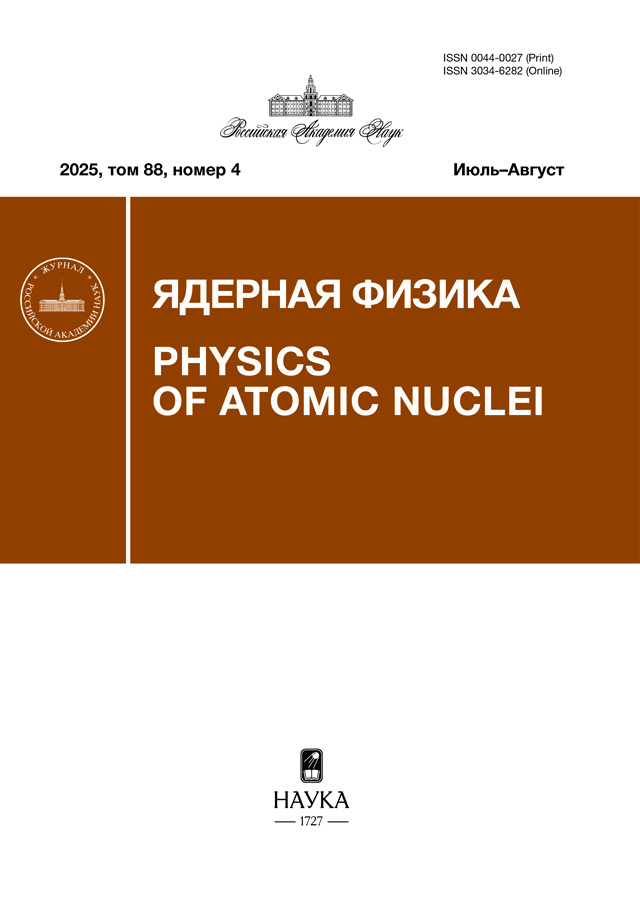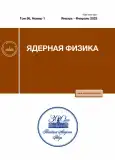ЭЛЛИПТИЧЕСКИЙ ПОТОК ДЛЯ \(\boldsymbol{\pi}^{\mathbf{0}}\)-МЕЗОНОВ В АСИММЕТРИЧНОЙ СИСТЕМЕ СТОЛКНОВЕНИЙ \(\mathbf{Cu}\boldsymbol{+}\mathbf{Au}\) ПРИ \(\sqrt{\boldsymbol{S}_{\boldsymbol{NN}}}\boldsymbol{=200}\) ГэВ
- Авторы: Банников Е.В.1, Бердников А.Я.1, Бердников Я.А.1, Котов Д.О.1, Митранков Ю.М.1, Митранкова М.М.1, Ларионова Д.М.1
-
Учреждения:
- Санкт-Петербургский политехнический университет Петра Великого
- Выпуск: Том 86, № 1 (2023)
- Страницы: 220-224
- Раздел: МАТЕРИАЛЫ LXXII МЕЖДУНАРОДНОЙ КОНФЕРЕНЦИИ “ЯДРО-2022: ФУНДАМЕНТАЛЬНЫЕ ВОПРОСЫ И ПРИЛОЖЕНИЯ”. Элементарные частицы и поля. Эксперимент
- URL: https://journals.rcsi.science/0044-0027/article/view/139675
- DOI: https://doi.org/10.31857/S0044002723010087
- EDN: https://elibrary.ru/QZYAAR
- ID: 139675
Цитировать
Полный текст
Аннотация
Эллиптический поток является одной из основных наблюдаемых, характеризующих коллективные эффекты на начальной стадии формирования кварк-глюонной плазмы в столкновениях ультрарелятивистских ядер. Выходы \(\pi^{0}\)-мезонов измеримы вплоть до больших значений поперечного импульса, поэтому измерение эллиптических потоков для \(\pi^{0}\)-мезонов является эффективным способом исследования свойств кварк-глюонной плазмы. Измерение эллиптических потоков в асимметричных системах столкновений позволяет изучить зависимость эллиптического потока от начальной геометрии системы. В данной работе рассмотрены две методики измерения эллиптического потока для \(\pi^{0}\)-мезонов в асимметричной системе столкновений \(\textrm{Cu}+\textrm{Au}\) при энергии \(\sqrt{S_{NN}}=200\) ГэВ.
Об авторах
Е. В. Банников
Санкт-Петербургский политехнический университет Петра Великого
Email: bannikov.ev.21@gmail.com
Россия, Санкт-Петербург
А. Я. Бердников
Санкт-Петербургский политехнический университет Петра Великого
Email: bannikov.ev.21@gmail.com
Россия, Санкт-Петербург
Я. А. Бердников
Санкт-Петербургский политехнический университет Петра Великого
Email: bannikov.ev.21@gmail.com
Россия, Санкт-Петербург
Д. О. Котов
Санкт-Петербургский политехнический университет Петра Великого
Email: bannikov.ev.21@gmail.com
Россия, Санкт-Петербург
Ю. М. Митранков
Санкт-Петербургский политехнический университет Петра Великого
Email: bannikov.ev.21@gmail.com
Россия, Санкт-Петербург
М. М. Митранкова
Санкт-Петербургский политехнический университет Петра Великого
Email: bannikov.ev.21@gmail.com
Россия, Санкт-Петербург
Д. М. Ларионова
Санкт-Петербургский политехнический университет Петра Великого
Автор, ответственный за переписку.
Email: bannikov.ev.21@gmail.com
Россия, Санкт-Петербург
Список литературы
- H. Buesching et al., Nucl. Part. Phys. 31, 473 (2005).
- R. Seto, Act. Phys. Pol. B 36, 525 (2005).
- M. L. Miller, K. Reygers, S. J. Sanders, and P. Steinberg, Ann. Rev. Nucl. Part. Sci. 57, 205 (2007).
- PHENIX Collab. (K. Adcox, S. S. Adler, S. Afanasiev, C. Aidala, N. N. Ajitanand, Y. Akiba, A. Al-Jame, J. Alexander, R. Amirikas, K. Aoki, L. Aphecetche, Y. Arai, R. Armendariz, S. H. Aronson, R. Averbeck, T. C. Awes, et al.), Nucl. Phys. A 757, 184 (2005).
- G. Policastro, D. T. Son, and A. O. Starinets, Phys. Rev. Lett. 87,081601 (2001).
- A. Poskanzer and S. Voloshin, Phys. Rev. C 58, 1671 (1998).
- A. Adare, S. Afanasiev, C. Aidala, N. N. Ajitanand, Y. Akiba, H. Al-Bataineh, J. Alexander, A. Angerami, K. Aoki, N. Apadula, Y. Aramaki, E. T. Atomssa, R. Averbeck, T. C. Awes, B. Azmoun, V. Babintsev, et al., Phys. Rev. C 88, 064910 (2013).
- R. Snellings, New J. Phys. 13, 055008 (2011).
- K. Adcox, S. S. Adler, M. Aizama, N. N. Ajitanand, Y. Akiba, H. Akikawa, J. Alexander, A. Al-Jamel, M. Allen, G. Alley, R. Amirikas, L. Aphecetche, Y. Arai, J. B. Archuleta, J. R. Archuleta, R. Armendariz, et al., Nucl. Instrum. Methods A 499, 469 (2003).
- L. Aphecetche, T. C. Awes, J. Banning, S. Bathe, A. Bazilevsky, S. Belikov, S. T. Belyaev, C. Blume, M. Bobrek, D. Bucher, V. Bumazhnov, H. Büsching, S. Chernichenkov, V. Cianciolo, M. Cutshaw, D. G. D’Enterria, et al., Nucl. Instrum. Methods A 499, 521 (2003).
- A. Adare et al. (PHENIX Collab.), Phys. Rev. C 78, 044902 (2008).
- Drijard, Daniel, H. G. Fischer, and T. Nakada, Nucl. Instrum. Methods A 225, 367 (1984).
- S. Afanasiev et al. (PHENIX Collab.), Phys. Rev. C 80, 024909 (2009).
- N. Borghini and J.-Y. Ollitrault, Phys. Rev. C 70, 064905 (2004).
- J. Barrette, R. Bellwied, S. Bennett, P. Braun-Munzinger, W. C. Chang, W. E. Cleland, M. Clemen, J. Cole, T. M. Cormier, G. David, J. Dee, O. Dietzsch, M. Drigert, J. R. Hall, T. K. Hemmick, N. Herrmann, et al., Phys. Rev. C 56, 2336 (1997).
- Iu. Mitrankov, E. V. Bannikov, A. Ya. Berdnikov, Ya. A. Berdnikov, and D. O. Kotov, J. Phys.: Conf. Ser. 2103,012133(2021).
- A. Adare et al. (PHENIX Collab.), Phys. Rev. C 94, 064901 (2016).
- M. Oldenburg, in Proceedings of the 14th Topical Conference on Hadron Collider Physics (2002), p. 215.
Дополнительные файлы










